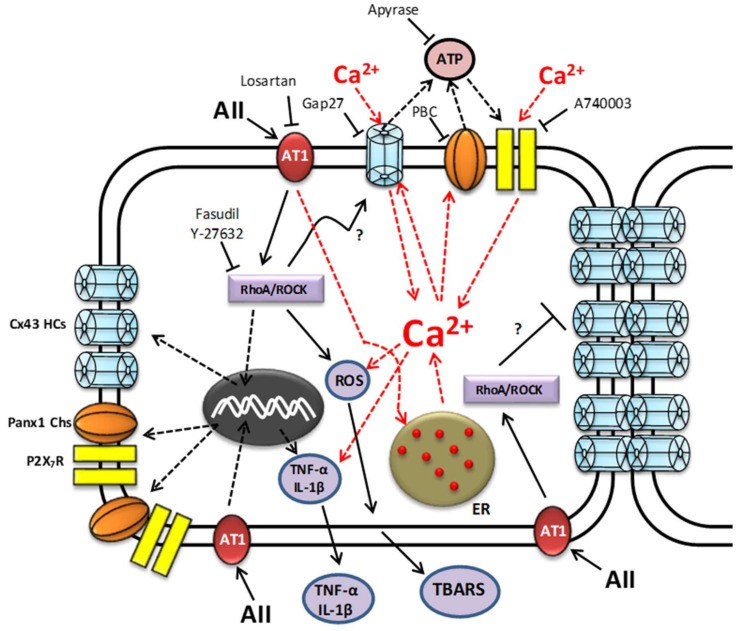Figure 10.
Scheme of possible signaling pathways involved in regulating the functional state of Cx43 HCs, Panx1 Chs, P2X7Rs and Cx GJs in mesangial cells stimulated with AngII. High AngII concentrations (continuous black arrows) could promote Ca2+ release from the endoplasmic reticulum (ER) and activation of a RhoA/ROCK-dependent pathway through angiotensin type 1 receptors (AT1R). The latter is inhibited by losartan. Once the RhoA/ROCK-dependent pathway is activated, the expression and release of pro-inflammatory cytokines such as TNF-α and IL-1β as well as formation of reactive oxygen species (ROS) that generate thiobarbituric acid reactive substances (TBARS) upon reaction with lipid of cell membranes can occur. The activated RhoA/ROCK-dependent pathway could affect the function of Cx43 HCs by opening them, since Fasudil or Y-27632 (ROCK blockers) inhibit this response. The resulting increase in intracellular Ca2+ can also activate Panx1 Chs and together with activated Cx HCs enable release of ATP to the extracellular medium. Then, the extracellular ATP activates P2X7 receptors that together with Cx43 HCs permit a drastic increase in Ca2+ influx. The resulting intracellular Ca2+ concentration, as already seen in other systems, promote the expression and release of pro-inflammatory cytokines such as TNF-α, IL-1β, and the generation of ROS. The release of ATP and influx of Ca2+ establish a positive feedback loop. This loop is inhibited by different compounds: Apyrase, ATP hydrolase; the mimetic peptide Gap27, a selective Cx43 HCs blocker; A740003, a selective P2X7R blocker or probenecid (PBC), an inhibitor of Panx1 Chs. This increase in the cellular activity caused by AngII, where the RhoA/ROCK pathway could be involved, also reduces cell–cell communication through GJs, further affecting the cellular integrity. Discontinuous red and black arrows indicate cell responses identified in other systems, whereas continuous black arrows denote responses identified in the present work.

